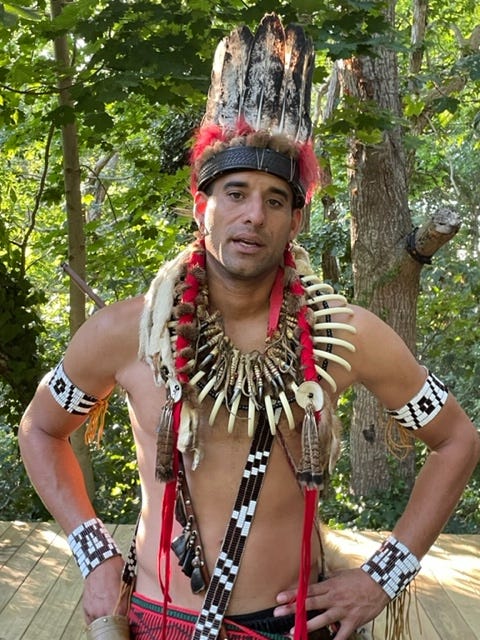Red Hawk Singers and Dancers defy forgetfulness
Here on Turtle Island, an alternative perspective
CheeNulKa Pocknett, head of the Red Hawk Singers and Dancers, performs in Wampanoag garb and between dances and songs offers perspectives rooted in the Mashpee tribe’s history and vision. For example, he’ll say that at an early age his elders taught him something important:
There are three sides to every story. There’s the victor’s side, the loser’s side – and then there’s the truth.
He paused to let that sink in during a small show in Wellfleet in August, the poignancy deeper given the hard history of Wampanoag interaction with European settlers, how “Thanksgiving” has been interpreted by the “victors,” how land ownership has evolved in Mashpee, a town created to be Native owned and controlled. Then he and his younger cousin Nathan Mills (former Chief Earl Mills a common grandfather), who trace ancestors back to King Philip (they say back through Ice Ages), resumed dances and drumming, circling, hopping like crows, crouching as if hunting, whirling like birds.
It’s interesting that the Barnstable public school sports teams had been known for so long as the Red Raiders (now renamed, like the troupe, the Red Hawks). But when you look at how the earliest Europeans conducted themselves, wouldn’t it have been more accurate to call them the White Raiders?
CheeNulKa (pronounced Chee-NOOL-kay) says his grandfather named him, meaning Big Deer, or Tall Deer. Now 37 years old, well over six feet, the name seems apt. He’s taken over the troupe and his three kids, 14, 9, and 6, dance with him at times. CheeNulKa wears tall feathers, otter and fox skins, necklaces of eagle and bear claws, bone whistles, a powder horn, bracelets and arm bands patterned like quahog shell (wampum), a bib covered with his grandmother’s beads she bought in 1902. He combines newer and older materials, replacing wampum with contemporary plastic and bear claws with replicas because the real ones are too rare and valuable to lug around, carrying a wooden facsimile of a musket and ax. He does not pretend to be authentic to one moment in history, a living museum piece. Neither does he pretend to be someone he is not.
We call this place Turtle Island, meaning the United States and Canada. We were brought down and put on the Turtle’s back long long ago, and we’re still here.
At times Red Hawk has involved dozens of 75 dancers, CheeNulKa says, not all from Mashpee. From June through September they have been at Lake George, New York, three days a week; the same day CheeNulKa and his cousin were in Wellfleet, a group was at Mohegan Sun, bridging the worlds of gambling and tradition. Tribal competitions surface in the East, West, the Plains between. Fairs and pow wows attract visitors, and prizes for best performances can reach thousands, even tens of thousands of dollars.
Men are life takers, life alterers. Women are life givers, life sustainers. That’s why -- though most people don’t realize this -- we are matriarchal, and why we are going to do a song in celebration of women and our clan mothers next.
Like many Wampangoag members, CheeNulKa worked for awhile at Plimoth Plantation, which has a replica village meant to look like a 1600s European settlement and another area supposedly showing tribal life at the time. He is disdainful of that tribal expression, finds it outrageous, disgusting, untrue, underfunded, not in keeping with the original vision and respect it was meant to convey. He hopes to be part of another effort to represent Native life at the time of first meetings, as well as playing a big role in tribal effort to create a strong aquaculture operation on large tidal grants they control. In the meantime, he continues mixing his dancing with a form of sermonizing:
Corns, beans, and squash, they work together. Corn stalks allow the beans to climb up. Squash spread broad leaves to keep the soil cool and moist. They’re symbiotic, and together feed us well. We haven’t forgotten that.
Forgetfulness of modern culture hovers over this conversation; what people remember and celebrate versus what they ignore or alter (as Wampanoags say men are wont to do) is how history is created and recreated. The depth to which Native experience on Cape Cod has been ignored, even disdained, is convenient for modern-day living but surely not true, or honorable.
That doesn’t mean we need to romanticize the Mashpees, who have their own leadership troubles and deep crosscurrents. But they were here long before white people, and honest histories show they offered help to arrivals that too often was betrayed. They nearly were exterminated. So we should not forget they still exist, an accomplishment marked by drum, dance, and differing perspectives.
Do you know what was the first book made in America? It was the Bible, translated into Wampanoag.








Important lesson Seth, thanks for the illumination.